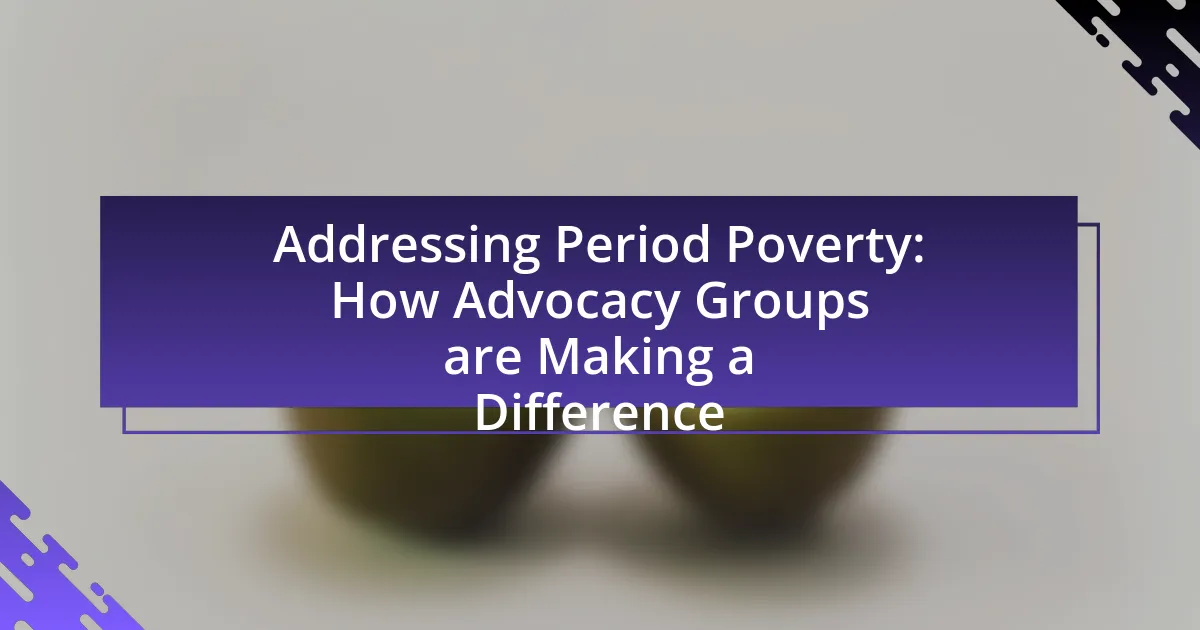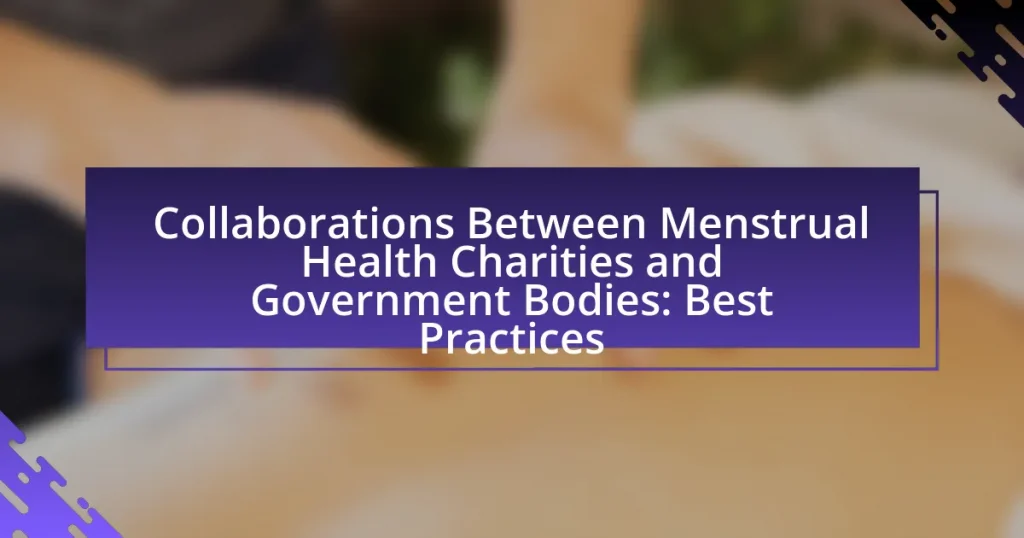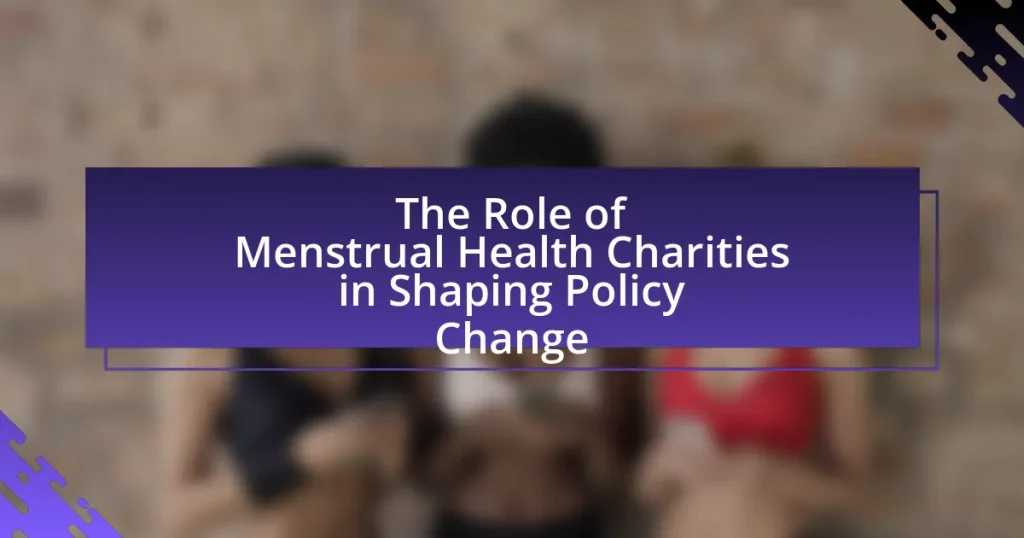Period poverty is a critical issue characterized by the lack of access to menstrual products, hygiene facilities, and education about menstruation, significantly impacting health, education, and economic opportunities for individuals, particularly women and girls. This article explores the multifaceted effects of period poverty on individuals and communities, including educational disruptions and social stigma, while highlighting the root causes such as economic instability and societal attitudes. It also examines the role of advocacy groups in addressing period poverty through educational initiatives, product distribution, and policy advocacy, as well as the challenges they face, including funding limitations and stigma. The article underscores the importance of community engagement and individual contributions in combating period poverty and promoting menstrual health equity.
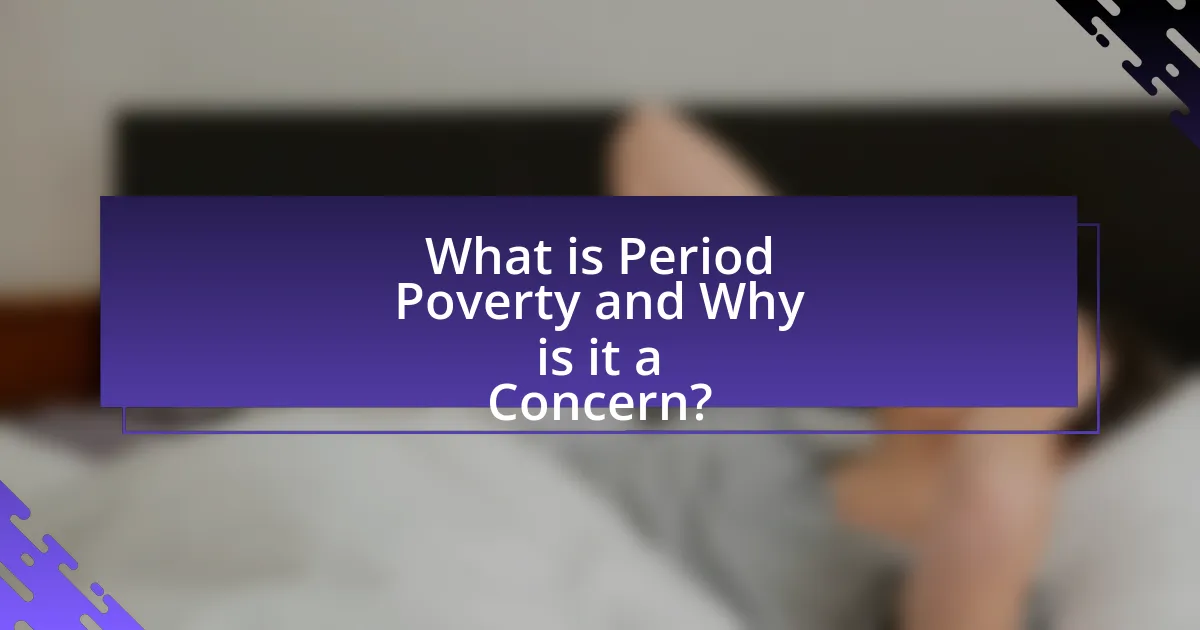
What is Period Poverty and Why is it a Concern?
Period poverty refers to the lack of access to menstrual products, hygiene facilities, and education regarding menstruation, which affects individuals’ ability to manage their periods safely and with dignity. This issue is a concern because it can lead to significant health risks, social stigma, and educational disruptions; for instance, studies indicate that 1 in 10 girls in Africa miss school during their menstrual cycle due to inadequate access to sanitary products. Addressing period poverty is crucial for promoting gender equality, health, and education, as it directly impacts the well-being and opportunities of those affected.
How does Period Poverty affect individuals and communities?
Period poverty significantly impacts individuals and communities by limiting access to menstrual hygiene products, which can lead to health issues, educational disruptions, and economic disadvantages. Individuals facing period poverty often experience shame and stigma, resulting in social isolation and mental health challenges. For instance, a study by the Global South Coalition found that 1 in 5 girls in low-income countries miss school during their periods due to a lack of sanitary products, which directly affects their education and future opportunities. Communities suffer as well, as the inability to manage menstruation can perpetuate cycles of poverty and gender inequality, hindering overall social and economic development.
What are the social implications of Period Poverty?
Period poverty has significant social implications, primarily affecting women’s health, education, and economic participation. Women and girls experiencing period poverty often miss school or work due to a lack of access to menstrual products, which can lead to lower educational attainment and reduced job opportunities. According to a study by the Global Menstrual Health Coalition, 1 in 10 girls in Africa misses school during their menstrual cycle, highlighting the impact on education. Furthermore, the stigma surrounding menstruation can lead to social isolation and mental health issues, exacerbating gender inequality. Access to menstrual hygiene products is essential for empowering women and ensuring their full participation in society.
How does Period Poverty impact education and employment?
Period poverty significantly hinders education and employment opportunities for individuals who menstruate. Lack of access to menstrual products often leads to absenteeism in schools and workplaces, as individuals may miss classes or workdays due to the inability to manage their periods effectively. For instance, a study by the Global Citizen reported that 1 in 10 girls in Africa misses school during their menstrual cycle, which can lead to a decline in academic performance and increased dropout rates. Furthermore, in the workplace, employees facing period poverty may experience decreased productivity and increased stress, ultimately affecting their job retention and career advancement. This cycle of missed educational and employment opportunities perpetuates economic inequality and limits personal and professional growth for those affected.
What are the root causes of Period Poverty?
The root causes of Period Poverty include economic instability, lack of access to menstrual products, inadequate education about menstruation, and social stigma surrounding menstruation. Economic instability often leads to insufficient financial resources for purchasing sanitary products, which affects individuals’ ability to manage their menstrual health. Lack of access to menstrual products is exacerbated in low-income communities where these items may not be readily available or affordable. Inadequate education about menstruation contributes to misinformation and fear, preventing individuals from seeking help or understanding their needs. Social stigma surrounding menstruation can lead to isolation and shame, further complicating access to necessary resources and support. These factors collectively create an environment where individuals struggle to manage their menstrual health effectively.
How do economic factors contribute to Period Poverty?
Economic factors significantly contribute to Period Poverty by limiting access to affordable menstrual products and hygiene facilities. Low-income individuals often struggle to afford basic necessities, including sanitary items, which can lead to missed school or work days. According to a study by the Global Citizen organization, 1 in 10 girls in Africa misses school during their menstrual cycle due to a lack of access to sanitary products, highlighting the direct impact of economic constraints on menstrual health. Furthermore, economic instability can exacerbate stigma and misinformation surrounding menstruation, further isolating those affected and perpetuating the cycle of poverty.
What role does stigma play in perpetuating Period Poverty?
Stigma plays a significant role in perpetuating Period Poverty by creating an environment where menstruation is viewed as shameful or taboo. This stigma leads to a lack of open discussion about menstrual health, resulting in inadequate education and awareness about menstrual hygiene management. According to a study published in the journal “BMC Women’s Health,” 70% of girls in low-income countries reported feeling embarrassed about menstruation, which directly affects their ability to access necessary menstrual products and support. The fear of stigma can prevent individuals from seeking help or resources, thereby exacerbating the cycle of poverty related to menstruation.
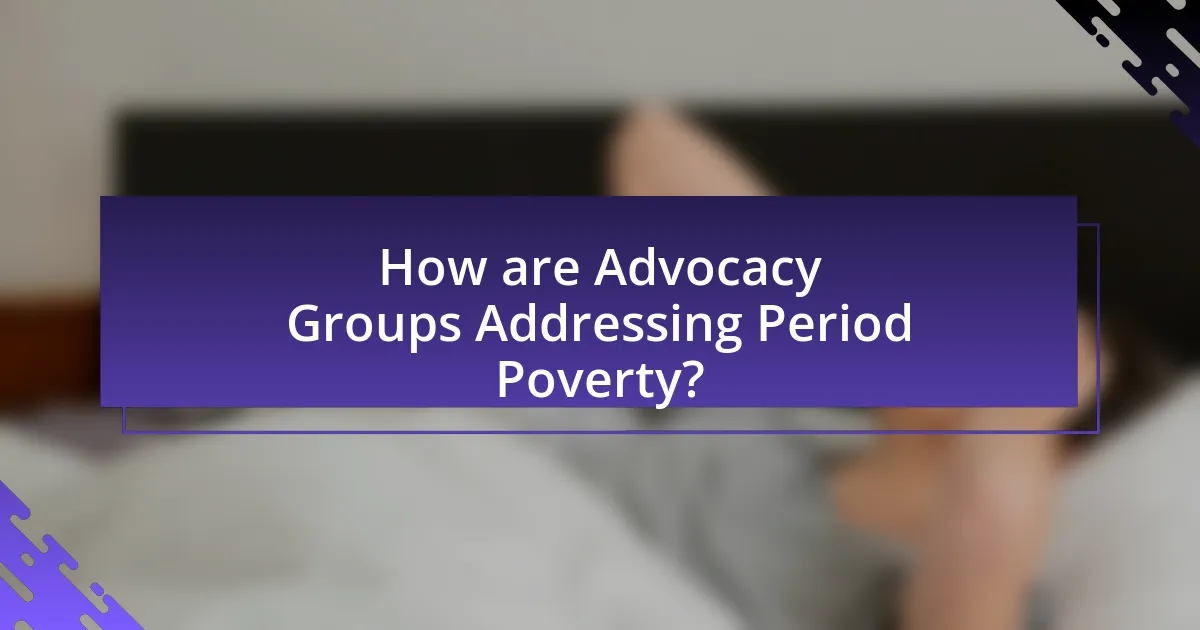
How are Advocacy Groups Addressing Period Poverty?
Advocacy groups are addressing period poverty by implementing educational programs, distributing menstrual products, and advocating for policy changes. These organizations, such as Period and Days for Girls, focus on raising awareness about the impact of period poverty on health and education, particularly among marginalized communities. For instance, studies indicate that one in four girls in the U.S. has missed school due to lack of access to menstrual products, highlighting the urgency of their initiatives. By providing free menstrual supplies and promoting menstrual health education, advocacy groups aim to eliminate stigma and ensure that all individuals have access to necessary resources.
What strategies are advocacy groups employing to combat Period Poverty?
Advocacy groups are employing strategies such as policy advocacy, educational campaigns, and direct distribution of menstrual products to combat Period Poverty. Policy advocacy involves lobbying for legislation that mandates free access to menstrual products in schools and public facilities, which has been shown to improve attendance and educational outcomes for menstruators. Educational campaigns aim to raise awareness about menstrual health and hygiene, reducing stigma and misinformation, which is crucial in communities where cultural taboos exist. Additionally, direct distribution initiatives provide menstrual products to underserved populations, addressing immediate needs and ensuring that menstruators have access to necessary supplies. For instance, organizations like Period.org have distributed over 1.5 million menstrual products to those in need, demonstrating the effectiveness of these strategies in alleviating Period Poverty.
How do advocacy groups raise awareness about Period Poverty?
Advocacy groups raise awareness about Period Poverty through educational campaigns, community outreach, and social media engagement. These organizations often conduct workshops and seminars to inform the public about the challenges faced by individuals experiencing Period Poverty, including the lack of access to menstrual products and the stigma surrounding menstruation. For instance, campaigns like “Menstrual Hygiene Day” aim to highlight the importance of menstrual health and hygiene, reaching millions globally. Additionally, advocacy groups utilize social media platforms to share personal stories, statistics, and infographics that illustrate the impact of Period Poverty, thereby fostering a broader conversation and encouraging public support for policy changes.
What partnerships are formed to tackle Period Poverty effectively?
Partnerships formed to tackle Period Poverty effectively include collaborations between non-profit organizations, government agencies, and private sector companies. For instance, organizations like Days for Girls partner with local governments and schools to distribute menstrual hygiene products and provide education on menstrual health. Additionally, companies such as Procter & Gamble have teamed up with various NGOs to ensure access to sanitary products in underserved communities. These partnerships leverage resources and expertise to create comprehensive solutions, as evidenced by initiatives that have successfully reached millions of individuals in need, thereby reducing stigma and improving health outcomes related to menstruation.
What successes have advocacy groups achieved in addressing Period Poverty?
Advocacy groups have successfully raised awareness and influenced policy changes to combat Period Poverty. For instance, in the UK, organizations like Plan International and the Red Box Project have successfully lobbied for the provision of free menstrual products in schools, resulting in the implementation of policies that ensure access for students. Additionally, in Scotland, advocacy efforts led to the passing of the Period Products (Free Provision) (Scotland) Act 2021, making menstrual products freely available to anyone who needs them. These achievements demonstrate the effectiveness of advocacy groups in addressing the systemic issues surrounding Period Poverty.
What legislative changes have been influenced by advocacy efforts?
Legislative changes influenced by advocacy efforts include the implementation of laws mandating free menstrual products in schools and public facilities. For instance, California passed a law in 2017 requiring public schools to provide free menstrual products in grades 6-12, driven by advocacy groups highlighting the impact of period poverty on education. Similarly, New York City enacted a law in 2016 to provide free menstrual products in public schools and shelters, reflecting the advocacy for equitable access to hygiene products. These changes demonstrate how organized efforts can lead to significant policy shifts addressing period poverty.
How have advocacy groups improved access to menstrual products?
Advocacy groups have improved access to menstrual products by implementing initiatives that provide free or subsidized products to underserved communities. For example, organizations like Period and the Alliance for Period Supplies have distributed millions of menstrual products through partnerships with schools, shelters, and food banks, addressing the needs of individuals facing period poverty. These efforts have been supported by research indicating that lack of access to menstrual products can lead to negative health and educational outcomes, highlighting the importance of these advocacy initiatives in promoting equity and health.
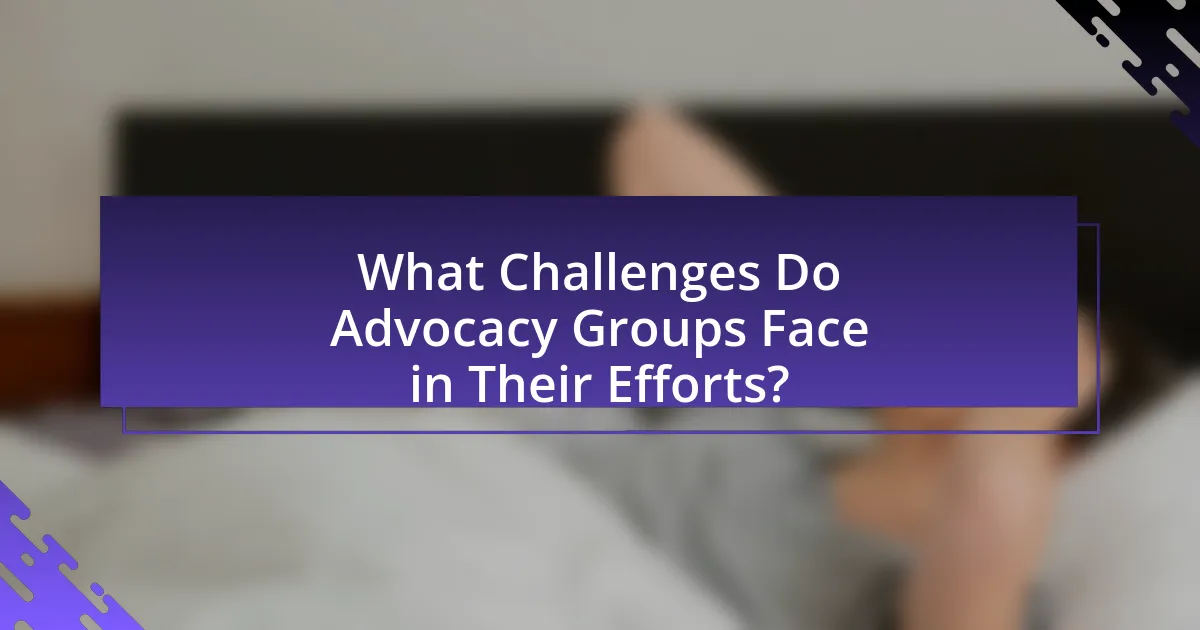
What Challenges Do Advocacy Groups Face in Their Efforts?
Advocacy groups face several challenges in their efforts to address period poverty, including limited funding, societal stigma, and legislative barriers. Limited funding restricts their ability to implement comprehensive programs and outreach initiatives, as many rely on donations and grants that may not be sufficient to meet the growing needs. Societal stigma surrounding menstruation often leads to a lack of awareness and support, making it difficult for these groups to engage communities effectively. Additionally, legislative barriers can hinder the distribution of menstrual products and the implementation of supportive policies, as advocacy groups often encounter resistance from policymakers who may not prioritize period poverty as a critical issue. These challenges collectively impede the progress of advocacy groups in their mission to alleviate period poverty.
What barriers hinder the effectiveness of advocacy groups?
Barriers that hinder the effectiveness of advocacy groups include limited funding, lack of public awareness, and political resistance. Limited funding restricts the resources available for outreach, research, and program implementation, which can diminish the group’s impact. A lack of public awareness about period poverty can lead to insufficient support and engagement from the community, making it difficult for advocacy groups to mobilize action. Political resistance often arises from policymakers who may not prioritize period poverty, resulting in inadequate legislative support and funding for initiatives aimed at addressing the issue. These barriers collectively impede the ability of advocacy groups to effectively address period poverty and implement meaningful change.
How does funding impact the work of advocacy groups?
Funding significantly impacts the work of advocacy groups by determining their capacity to implement programs, conduct research, and engage in outreach efforts. Adequate funding allows these organizations to hire staff, develop educational materials, and mobilize communities effectively. For instance, a study by the National Council of Nonprofits indicates that organizations with stable funding sources are more likely to achieve their advocacy goals, as they can allocate resources toward sustained campaigns and initiatives. Conversely, limited funding restricts advocacy groups’ ability to operate, leading to reduced visibility and influence in policy discussions related to issues like period poverty.
What challenges arise from societal attitudes towards menstruation?
Societal attitudes towards menstruation create significant challenges, including stigma, misinformation, and lack of access to menstrual products. Stigma surrounding menstruation often leads to shame and silence, preventing open discussions and education about menstrual health. Misinformation perpetuates myths that can harm individuals’ understanding of their own bodies, leading to negative health outcomes. Additionally, negative societal perceptions can result in inadequate support systems, making it difficult for individuals to access necessary menstrual products, which is a key factor in period poverty. According to a study by the World Bank, 1 in 10 girls in Africa misses school during their menstrual cycle due to a lack of access to sanitary products, highlighting the real-world implications of these societal attitudes.
How can advocacy groups overcome these challenges?
Advocacy groups can overcome challenges related to period poverty by implementing targeted educational campaigns and forming strategic partnerships. These groups can raise awareness about menstrual health and hygiene through workshops and community outreach, which helps to destigmatize the topic and inform individuals about available resources. For instance, organizations like Period.org have successfully collaborated with schools and local governments to distribute menstrual products and provide education, demonstrating the effectiveness of partnerships in addressing logistical barriers. Additionally, securing funding through grants and donations allows advocacy groups to expand their reach and sustain their initiatives, as evidenced by the increase in support for menstrual health programs in various regions.
What innovative approaches are being explored to address Period Poverty?
Innovative approaches being explored to address Period Poverty include the development of sustainable menstrual products, such as reusable pads and menstrual cups, which reduce long-term costs and environmental impact. Advocacy groups are also implementing educational programs that promote menstrual health awareness and destigmatization, ensuring that individuals understand their rights and options. Additionally, partnerships with local governments and organizations are facilitating the distribution of free or subsidized menstrual products in schools and communities, directly targeting those in need. For instance, initiatives like the “Menstrual Health Management” program by UNICEF have shown success in improving access to menstrual hygiene products and education in various countries.
How can community engagement enhance advocacy efforts?
Community engagement enhances advocacy efforts by fostering stronger connections between advocacy groups and the communities they serve. When community members actively participate in advocacy initiatives, they provide valuable insights and perspectives that can shape the direction and effectiveness of campaigns. For instance, research shows that advocacy efforts are more successful when they are informed by the lived experiences of those affected, as seen in initiatives addressing period poverty where local voices highlight specific needs and barriers. Engaging the community also builds trust and mobilizes support, leading to increased participation and resource allocation, which are critical for driving meaningful change.
What can individuals do to support the fight against Period Poverty?
Individuals can support the fight against Period Poverty by donating menstrual products to local shelters and organizations that assist those in need. Research indicates that one in four women in the U.S. has struggled to afford menstrual products, highlighting the urgency of this issue. Additionally, individuals can advocate for policy changes that promote free access to menstrual products in schools and public facilities, as seen in initiatives across various states that have successfully implemented such measures. Engaging in awareness campaigns and educating others about the impact of Period Poverty can further amplify efforts to address this critical issue.
How can people contribute to advocacy groups and initiatives?
People can contribute to advocacy groups and initiatives by volunteering their time, donating funds, and raising awareness about the issues at hand. Volunteering allows individuals to actively participate in campaigns, organize events, and support outreach efforts, which are essential for the success of advocacy initiatives. Financial contributions provide necessary resources for these groups to operate effectively, enabling them to expand their reach and impact. Additionally, raising awareness through social media, community events, or personal networks helps to educate others about period poverty and mobilizes further support for advocacy efforts. According to a report by the World Health Organization, increased awareness and community engagement are critical in addressing health-related issues, including period poverty, thereby validating the importance of these contributions.
What are effective ways to raise awareness about Period Poverty in local communities?
Effective ways to raise awareness about Period Poverty in local communities include organizing educational workshops, leveraging social media campaigns, and collaborating with local schools and health organizations. Educational workshops can provide information on the impact of Period Poverty, helping to destigmatize menstruation and promote understanding. Social media campaigns can reach a wider audience, utilizing statistics such as the fact that 1 in 5 girls in the U.S. have missed school due to lack of access to menstrual products. Collaborating with schools and health organizations can facilitate distribution of menstrual products and resources, ensuring that the issue is addressed within the community context.
